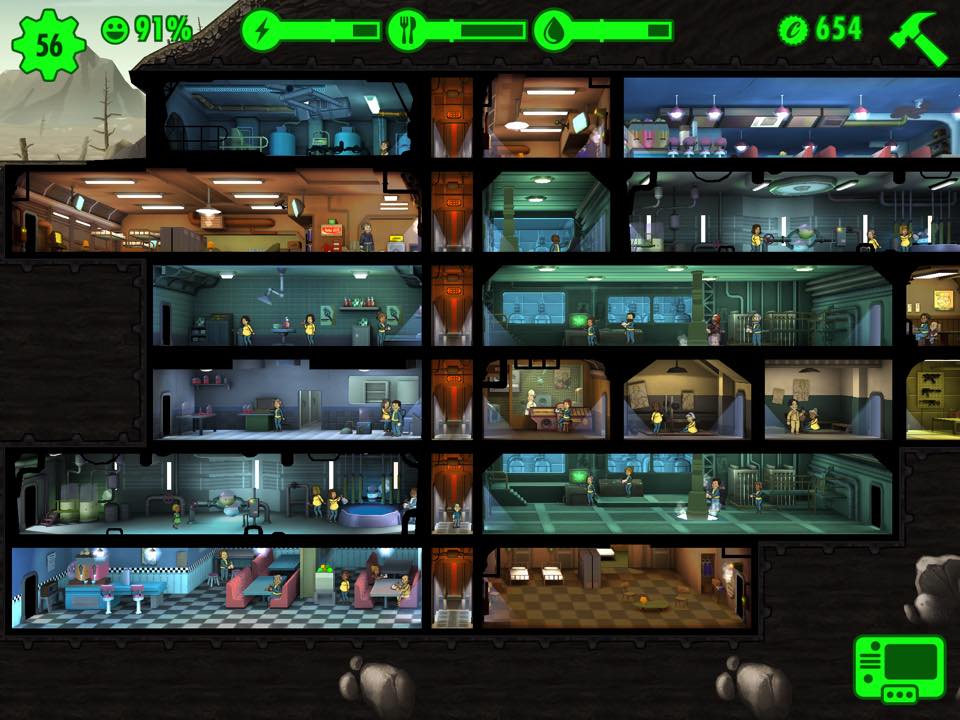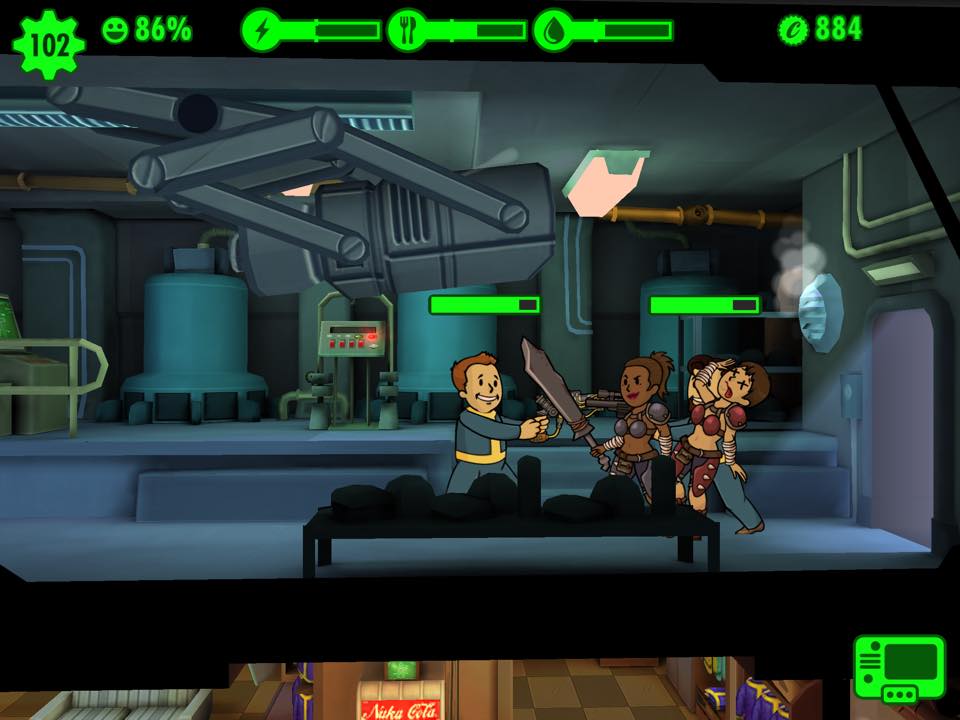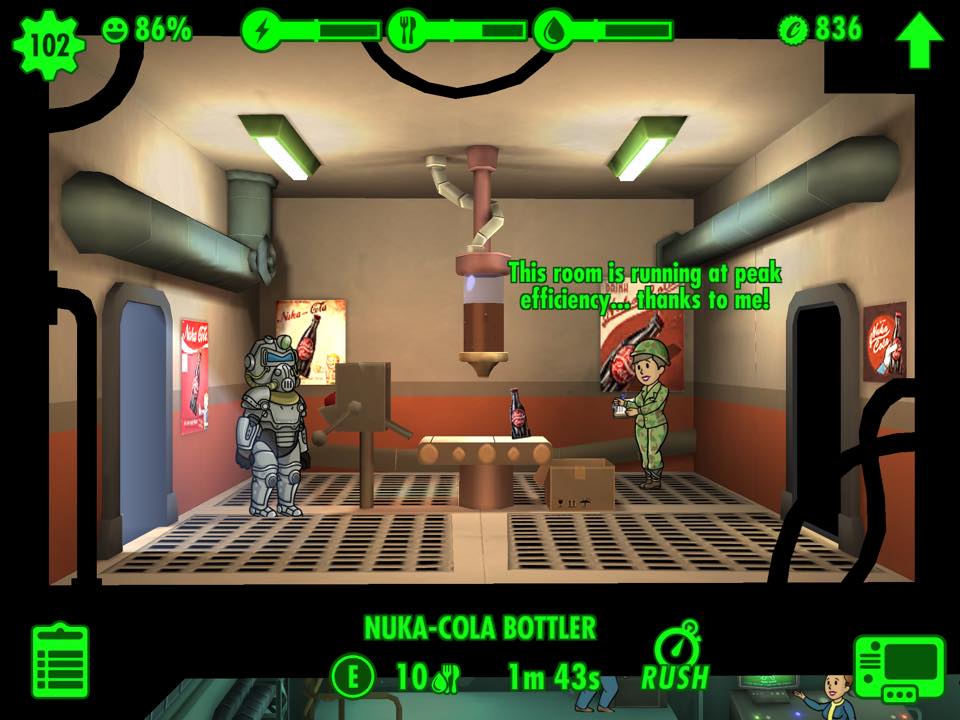Bethesda came out of the gate swinging at their first ever E3 Conference Sunday night. Among all the hype for Doom, Dishonored 2, and Fallout 4 came a few smaller announcements. One of those announcements was a new Fallout mobile game called Fallout Shelter(Free), a partnership between Bethesda and Behaviour Interactive, and it is just adorable. I mean, in a horribly grim-dark sort of way. Basically it’s a Tiny Tower (Free)style town management game set in the alternate history world of Fallout, and it is just oozing that Fallout style. The main points I’ll be covering are the Basics, Population Control, Baby Making, Caps Acquisition, Room Rushing, and Happiness.
Basics
So just what is going on in this crazy irradiated world, and how do you get ahead? I’ve been playing it non-stop since release, and I’ve made plenty of mistakes that I want to help the rest of you avoid. After choosing your very own Vault number you’re thrown right into the management with a handful of new vault dwellers. The key aspects that you need to manage are food, power, and water purification. If you run out of food and water, people start dying, and if you run out of power, you can’t produce those resources. The rooms will just go dark. The S.P.E.C.I.A.L. stat system of Falloutfame makes a return here. That’s Strength, Perception, Endurance, Charisma, Intelligence, Agility, and Luck, for those not in the know. Each dweller has these stats and each stat is used to increase the efficiency of certain rooms. Here’s a breakdown…
- Strength: Power Generator, Nuclear Generator.
- Perception: Water Treatment, Water Purification.
- Endurance: Storage Room, Nuka-Cola Bottler. Staffing the storage rooms doesn’t seem to have any effect on the vault, but may effect staffed dwellers happiness.
- Charisma: Living Quarters, Radio Studio. Very important for baby making and drawing new vault dwellers from the outside world.
- Intelligence: Medbay, Science Lab. Used to make Stimpaks and RadAways. Extremely important.
- Agility: Diner, Garden.
- Luck: Dwellers with high Luck are more successful at rushing rooms and potentially getting Caps bonuses whenever collecting resources.
Learning SPECIAL and keeping track of where each dweller should be can be a bit complicated at first, but it’s a pretty easy system to learn. As you drag a dweller from room to room, you’ll see what letter that room utilizes AND what stat number that dweller will contribute. Likewise, whenever looking at a dweller’s stats, even without blowing it up to see the exact numbers, you can tell which stat is which by quickly spelling and counting it out in your head. The tab in the top left lets you easily sort dwellers by status, SPECIAL, name, level, job, and happiness, only from largest to smallest. This makes it easy to find the right people for any job. If you see someone on a ‘Coffee Break’ that means they’re wandering aimlessly, and should be assigned somewhere or sent into the wastes.
Each room can be upgraded twice to increase efficiency. You can also build larger rooms, up to 3 cells long, by merging the same room-types together. The rooms have to be of the same level to merge, however, if you’re wondering why they aren’t. A single cell room can be staffed by 2 people at a time, and naturally it’s 4 for 2 cells, and 6 for 3 cells. The cost of a new room increases based on how many you have, but the upgrade costs remain constant. The main balancing act of the game is re-allocating people as things change. The game makes this easy for you. As you drag someone over a room, if it’s already full, a plus or minus will show up next to the stat number, showing whether it’s a positive or negative gain, automatically replacing the lowest stat person.
As your vault population increases, you’ll unlock more buildings that give you more abilities. Storage rooms that let you have more outfits and weapons, a Medbay and Science Lab for creating Stimpaks and RadAway for healing and irradiating your dwellers, a Radio station to broadcast out into the wastes, hopefully drawing in new vault dwellers from the outside world, and then training rooms for each individual stat…
- Strength: Weight Room
- Perception: Armory
- Endurance: Fitness Room
- Charisma: Lounge
- Intelligence: Classroom
- Agility: Athletics Room
- Luck: Game Room
Beyond that you have special new versions of the main three resource rooms, and eventually a Nuka-Cola bottling factory, which confers both food and drink, but shockingly no extra Caps, even in tiny amounts. Training goes faster if more than one person trains at a time. Likewise, training rooms do indeed count towards happiness, as the ‘right room assignment’ mission objective helped me understand.
Aside from the SPECIAL stats, vault dwellers can also be equipped with an outfit and a weapon. Outfits confer stat bonuses and weapons are used to fight off Radroaches, raiders, or to help your dweller survive if you send them scouting for items and Caps out in the wastes. They also level up over time, but leveling up doesn’t increase their stats. It only increases their health, which is still very important for fighting off those previously mentioned random disasters. Vice Versa, people in training rooms only increase stats, and don’t level up.
Fun fact. The game is smart enough to realize that when you pull in people from surrounding rooms to fight a disaster that you want those people BACK in those rooms right after. I’ve almost never had issues with getting people back in their assigned rooms. Also, weapon management is a pain if you give a bunch of people weapons and can’t remember who. Then you have to tap on each person and check, one by one. Make sure if you give people weapons for a crisis, you take them back immediately.
Population Control
The main balancing act of this game is in the population control. As you get more dwellers, you’ll need more clean water and food, and space. As you build more rooms to accommodate, you’ll need more power. Beyond the intro of the game, gaining new followers is generally molasses slow. With a single cell, level 2 radio room, staffed by two people with near max Charisma (19 out of a possible 20) I almost never got new dwellers from the outside. So how do you increase your population? The old fashioned way. Make new people. I mean, it is the apocalypse. It is your civic duty to repopulate the earth and ensure the survival of the human race, right?
Baby Making
You do this through the living quarters. Like the old saying goes, if you put two people in a room together long enough, eventually they’re going to… um. ‘Woohoo,’ to borrow a term from The Sims(Free). Dwellers with higher charisma will speed up the process. My one dweller with max Charisma had some dwellers throw themselves at him within seconds of entering the room. It was amusing. It’s easier from a game mechanics standpoint to just use the same few men and cycle in different women. This all sounds kind of creepy, I realize, but that’s OK.
Here’s where I made some mistakes. After a while, I had no issues with resources at all, and was focused entirely on expanding my population to unlock new rooms. So for a while there, I had more than half of the women in the vault pregnant at all times. When they’re pregnant, it only means that they won’t fight or put out fires, but otherwise they can still work, and they can still train their stats. If you don’t have room for more population, the babies will stay in their mother’s wombs indefinitely. Birth is automatic, and happens when it happens. This is pretty much the only way to grow your vault with any kind of speed. As a side note, if you notice two dwellers in the living quarters not acting all flirty or dancing, zoom in. They’re probably related, and they’ll probably say something about being related. Thankfully, this game keeps track of such things, and you can name each baby to make sure you know their parentage. No creepy, Game of Thrones, Crastor’s Keep stuff in my vault!
This was all fine and dandy until a certain birthing boom raised my population by 13 in the span of half an hour, and then I was struggling like mad to keep everyone happy and healthy, running low on food and clean water. Then, when I built new diners and water treatment rooms, I was running low on power. It was a nightmare. Pro-Tip: I deleted a bunch of stat training rooms to try to conserve power, only to learn that they had no noticeable effect at all. Same for storage. Other times when I was low on power, those rooms did go dark however, so it’s hard to say. It would be nice if the game charted power usage in specific integers and variables. Either way, don’t go doing that. The Caps refund is uselessly small and it’s very wasteful.
This was all compounded by the fact that most of my vault dwellers weren’t very high level, had low SPECIAL, and happiness was low all around. When happiness is low, vault dwellers work more slowly, which only stacks with your other problems. I’ll talk more about happiness later. On top of all this, my dwellers were irradiated to heck, talking about their bodies falling apart. This had never been an issue for me, so I didn’t have very many Stimpacks and RadAway. I had a full stock, but your maximum number is tied to how many/how big your Medbays and Labs are. So I ran out of those right quick too.
Outlived Their Usefulness
If you want to be really heartless, it is possible to reduce your population. You can either send someone out to the wastes empty handed and wait for them to die, or you can have someone rush a room over and over, until the fire and Radroaches kill them. More on rushing later.
So I’ll tell you right now. Don’t be over-eager to expand. It’s manageable at first, but once you have several dozen people, many of whom are low level with low stats, things get icky quick. It’s much harder to keep track of everyone and you have no time to really get to know who is who among your population. It’s agonizing to pace yourself in this game, but only birthing a few children at a time, keeping people’s stats up in the training rooms, and keeping some Caps in reserve and upgrading rooms before building new ones seems to be the best way. Any major changes can really offset your game. Speaking of Caps!
Making Bank with Nuka-Cola
Caps are essential in this game, especially if you need to build new rooms quickly. So how do you make Caps? Here are all the ways.
- Selling Weapons and Outfits
- Exploring the Wasteland
- Completing Objectives
- Leveling up a dweller
- Successfully rushing a room
- Sometimes earned by dwellers with high luck when collecting resources
As a freemium game, the monetization here is leagues better than most. You can’t even buy Caps directly! Kind of… Technically, every Lunchbox you buy is guaranteed to have some Caps in it, but it can also have various resources, weapons, outfits, and even characters, with one of those guaranteed to be rare or better.
If you really want, you can save these for when disaster strikes. It shouldn’t be necessary, and there’s no guarantee you’ll get the resources you need. Smart management should prevent this, and even I managed to survive my bad times with no loss of life. Awful happiness, but still no loss of life.
Rushing a Room
Room rushing is an interesting mechanic. It’s a complete gamble that isn’t even monetized and doesn’t exist to take advantage of you. If you rush a room’s timer, you can gain bonus experience and bonus Caps with every success. If you fail, you’ll have to deal with fire or Radroaches. As you continue rushing, the chance of failure will go up, but even at 75% and above, there is still a chance for success. And the higher that failure chance is, the more Caps you’ll get. Someone with high Luck is much more likely to succeed here. If you want to farm Caps, a couple high level people with high luck and good weapons in a room can be a godsend. Just be careful. Sometimes even one or two Radroaches can do massive damage. Don’t let your dwellers die unless you want to waste all those Caps you just earned reviving them. Even if you fail a rush, you’ll still get some of the bonus experience from fighting off that disaster.
It isn’t generally advisable to rush a room when you’re low on resources. Yes, you can get a bump in the meter from this, but if you fail, that down time spent fighting whichever disaster befalls you is a huge waste of time. Maybe rush once or twice when the failure rate is around 30%, but not beyond that if you’re already struggling for resources.
A Happy Dweller is a Productive Dweller
The last thing I’ll talk about is happiness. You want your vault dwellers to be happy. They’ll produce more resources and they won’t make you look at their dumb sad faces. Generally, as long as you’ve got plenty of resources, spirits will be pretty high. The way to push a vault dwellers happiness up is to have them working in a room that they specialize in. If they don’t specialize in anything, get them training. This brings most up to 75% or 85% happiness. For that last boost, sometimes the only thing to do is make them mate. Dwellers have always come out of WooHoo time with 100% happiness in my experience, and it lasts a while.Your happiness level will be tracked every 24 hours, so make sure you check in for your Caps. Once you’ve checked in 7 days in a row, you get a lunch box. When I had around 50 vault dwellers, happiness and management was easy. People in the Game Room ALWAYS had 100% happiness as well.
It’s worth mentioning that there are Game Center leaderboards in this game. One for points/score, which I don’t fully understand. One for best happiness, and another for highest number of rooms. Playing this game can feel a lot like spinning plates. Just keep growth slow and steady, and you’ll be fine. The tortoise and the hare and all that. Happy Overseeing!





